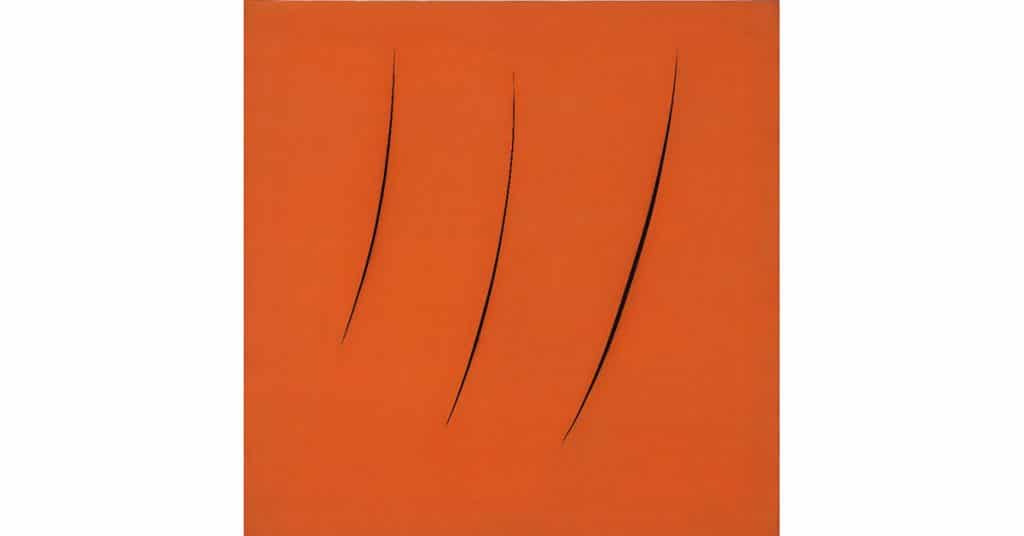Lucio Fontana On the Threshold, an exhibition of work by the Argentine–Italian artist, is at the Met Breuer, Met Fifth Avenue and El Museo del Barrio, from January 23 to April 14, 2019.
Lucio Fontana On the Threshold
The artist’s first major retrospective in the United States in more than forty years focuses on his famous Cuts series, but also explores his sculpture, ceramics and environments at the Met Breuer and Met Fifth Avenue. The exhibition shows how Fontana’s practice foretold performance art.
The exhibition is curated by Iria Candela, Estrellita B. Brodsky Curator of Latin American Art in The Met’s Department of Modern and Contemporary Art
Fontana’s last environment ‘Spatial Environment’ (1968) is being shown at El Museo del Barrio. He created it just before he died.
This full-scale reconstruction provides sort of a “Honey, I shrunk the gallery visitors” experience of his art. You get to walk around inside a room-size installation. It’s going to be a great New York selfie spot.
Lucio Fontana
Lucio Fontana was a minimalist abstract artist and theorist. He was born on February 19, 1899 in Rosario de Santa Fé, Argentina. He was raised in Milan from 1905-1922 when he returned to Argentina. During his artistic career, Fontana moved back and forth between Argentina, France and Italy where he died in 1968.
He studied with Italian sculptor Adolfo Wildt (1868-1931) at Accademia di Brera in Milan.
His “White Manifesto” (Altamira Academy, Buenos Aires, 1946) explored the idea of blending architecture and sculpture into painting. For some reason, architecture plays an important role in the practice of many Latin American artists. Perhaps it derives from a desire to improve the human condition which is so devastated by war and decolonization.
Fontana was the founder of “Spatialism,” the idea of breaking out of the two-dimensional picture plane by holing or slashing the canvas, or placing objects in context throughout the exhibition space. That suggests the later work of performance artists which completely escapes the picture plane.
Fontana is best known for “Concetti Spaziale” (Spatial Concepts), monochrome canvases that are cut or punctured. You can see Fontana’s influence on the work of Alberto Burri (Italian, 1915-1995).
Fontana’s Milan studio was completely destroyed by Allied bombings during World War II. The personal experience of deconstruction altered his artistic development. It was after the War that he began holing and slashing his work. Watching Fontana work is very much like watching Jackson Pollock do an action painting.
Fontana wanted to create an experience behind his art, but that also pushed him out in front of it. He became obsessed with the rebirth of humanity. In fact, his final series worked the shape of the egg. He extended the Italian Futurist idea of the improvement of humanity, but without the machines or violence. Those who have actually experienced war, are in no hurry to glorify or repeat it.
In the end, Fontana reduced his slashes to just one. It became a door into the future. You can read the single slash as a vulva. Love goes in and life comes out. In a way, Fontana’s dominant form mirrors the experience of being alive. The mechanics are done for you, but life is not something you can just observe. You have to actively participate to get the most out of it.
Fontana had a show in New York in 1961 at Martha Jackson Gallery. He won the Grand Prize for painting at the 1966 Venice Biennale.
In New York City, you can find Fontana’s work in the collections of MoMA and the Guggenheim, and occasionally in auctions at Christie’s and Sotheby’s. His work is also in collections at the Tate Modern, Centre Pompidou and other major collections around the world.
Some of Fontana’s work looks very simple. It generates the, “Well, I could do that” thought. But it is very difficult to make simplicity so beautiful.
Lucio Fontana On the Threshold Tickets
Metropolitan Museum of Art tickets are available at the door and online. $25
El Museo del Barrio tickets are available at the door. $9
Lucio Fontana On the Threshold & Related Exhibitions
The exhibition is a collaboration between The Metropolitan Museum of Art and Fondazione Lucio Fontana. It is accompanied by a catalog.
Met Breuer
945 Madison Avenue, New York, NY 10021
(at 75th St)
Upper East Side, Manhattan
Tuesday-Sunday
The exhibition is on Floors 3 and 5.
Metropolitan Museum
1000 Fifth Avenue, New York, NY 10028
(at 82nd St)
Upper East Side, Manhattan
Open daily.
The exhibition is in Gallery 913.
El Museo del Barrio
1230 Fifth Avenue, New York, NY 10029
(between 104th & 105th St)
East Harlem, Manhattan
Wednesday-Sunday

